Abstract
BACKGROUND: Pseudofolliculitis barbae affects some individuals with coarse curly hair. Currently available treatment modalities are often ineffective. In some studies, lasers have been shown to be potentially helpful in mitigating disease severity by reducing the number and/or thickness of hair shafts. METHODS: This was a side-by-side interventional study conducted at a military tertiary medical facility. The study group included 26 patients (skin types IV, V, and VI) referred from primary care physicians with a diagnosis of pseudofolliculitis barbae refractory to medical therapy. A neodymium YAG laser was used to treat one half of the neck. One month later, shaving bumps were counted and compared to their preoperative levels on both sides. RESULTS: Mean postoperative papule counts were 11.6 +/- 6 (SD) and 30.1 +/- 19 (SD) on the treated side and untreated sides, respectively. CONCLUSION: Neodymium YAG laser treatment represents a safe and effective option for reducing papule formation in patients with pseudofolliculitis barbae.
Full text
PDF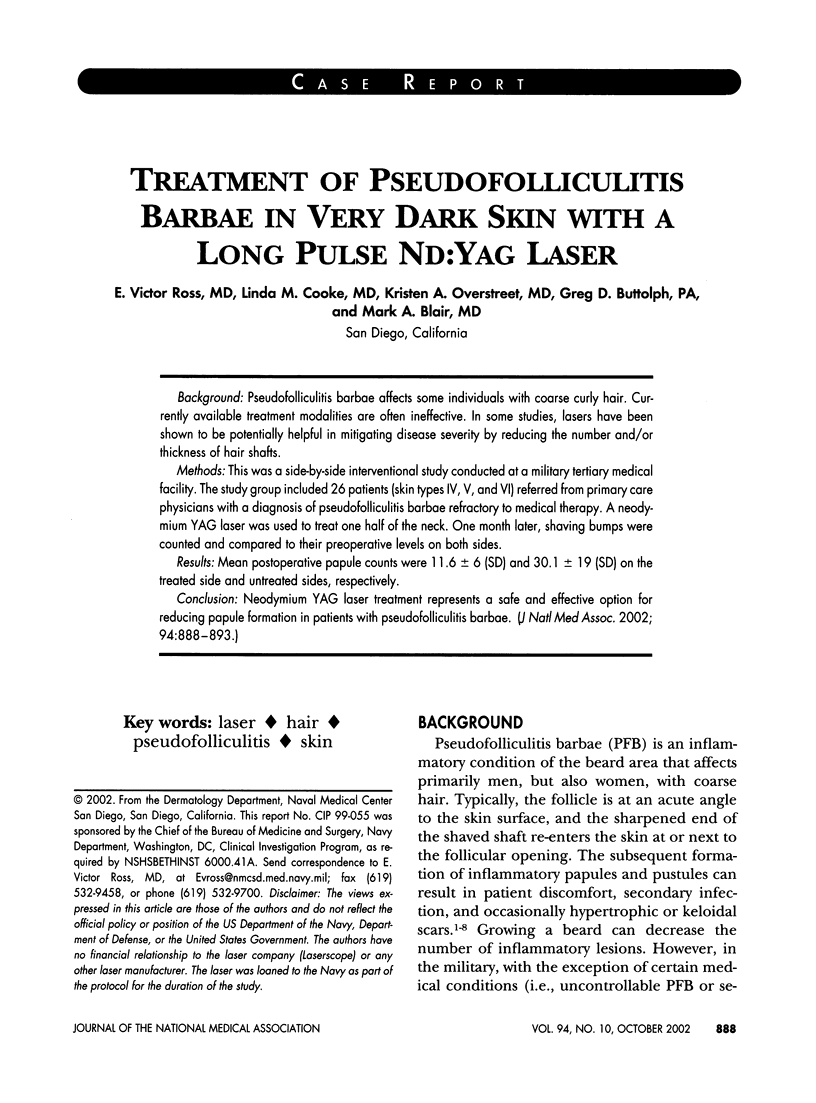
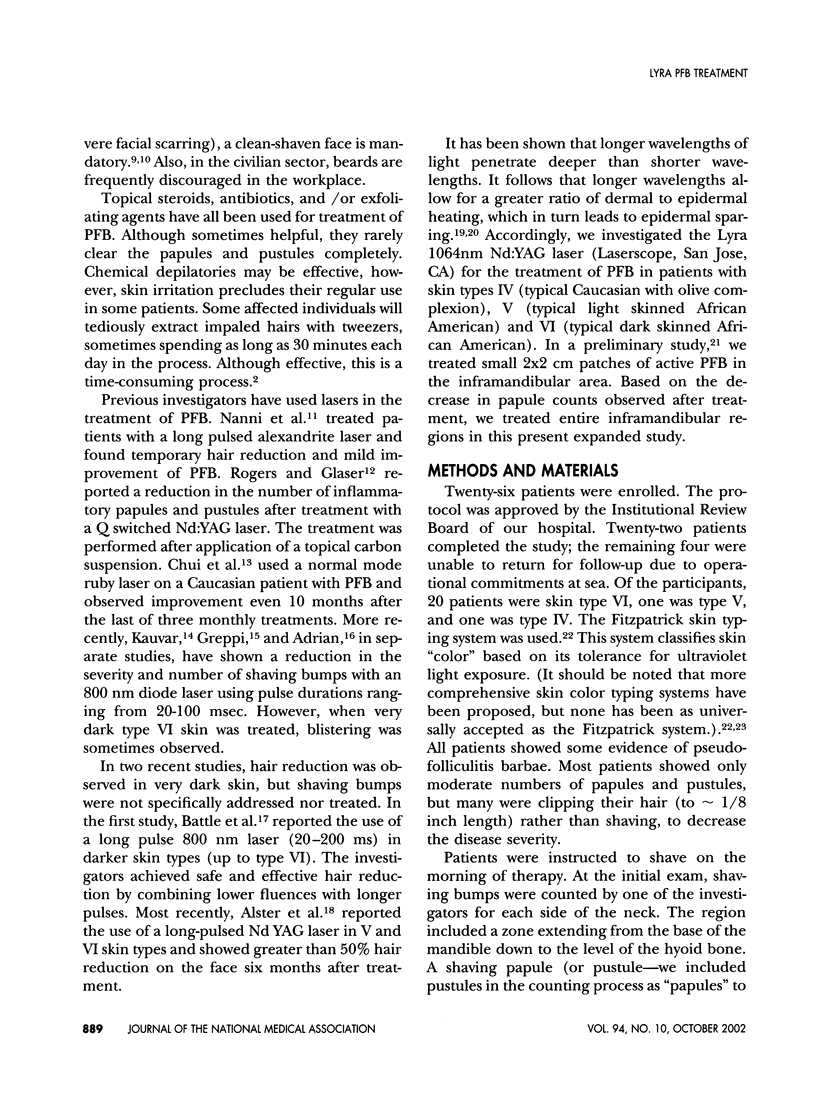
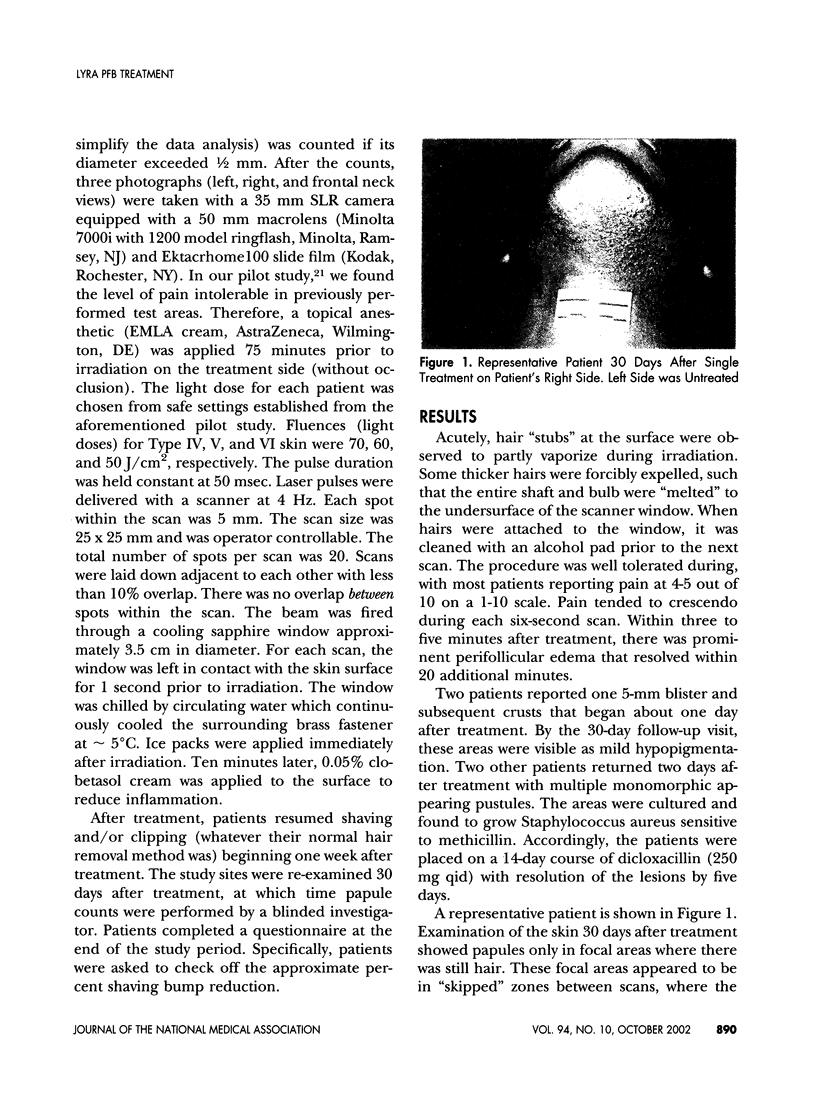
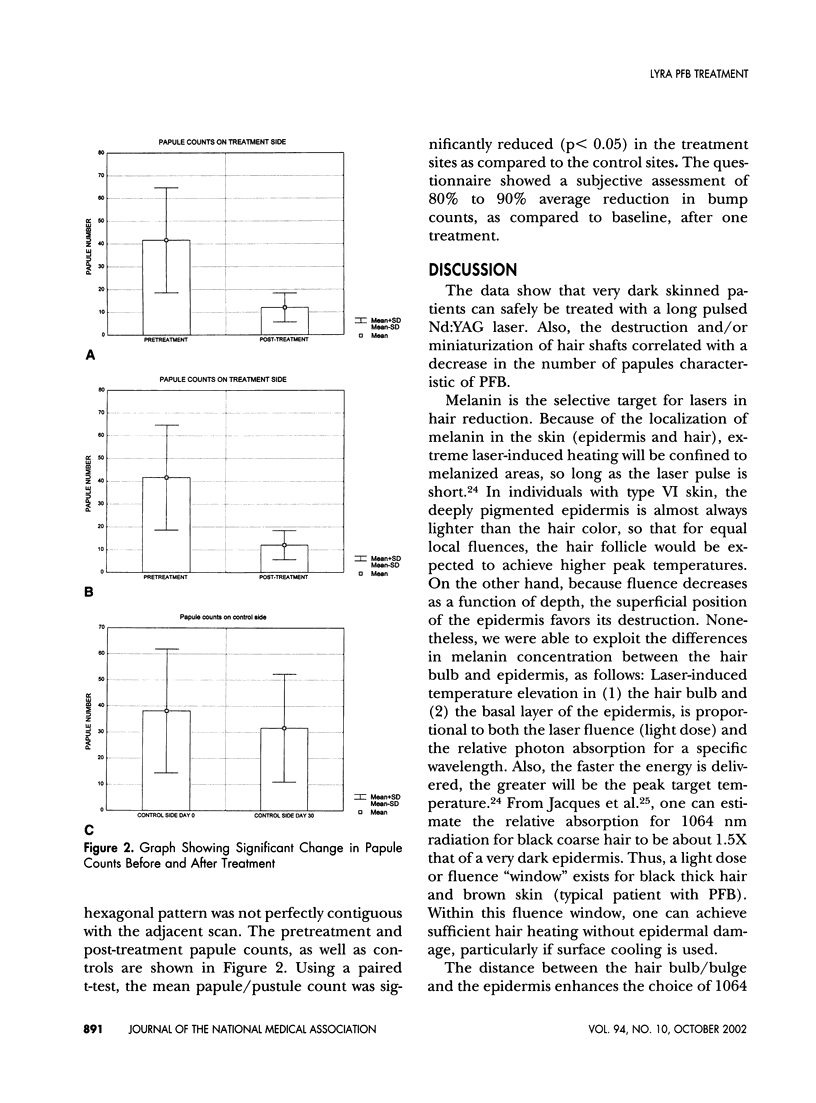
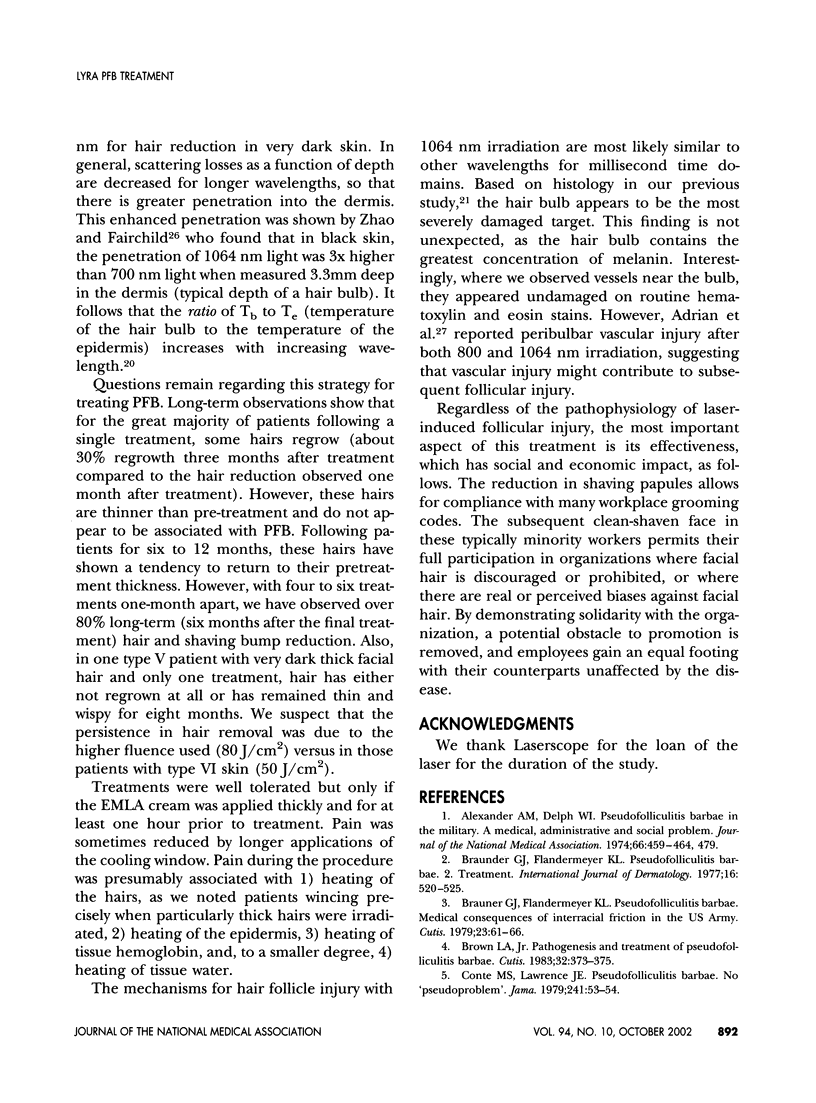
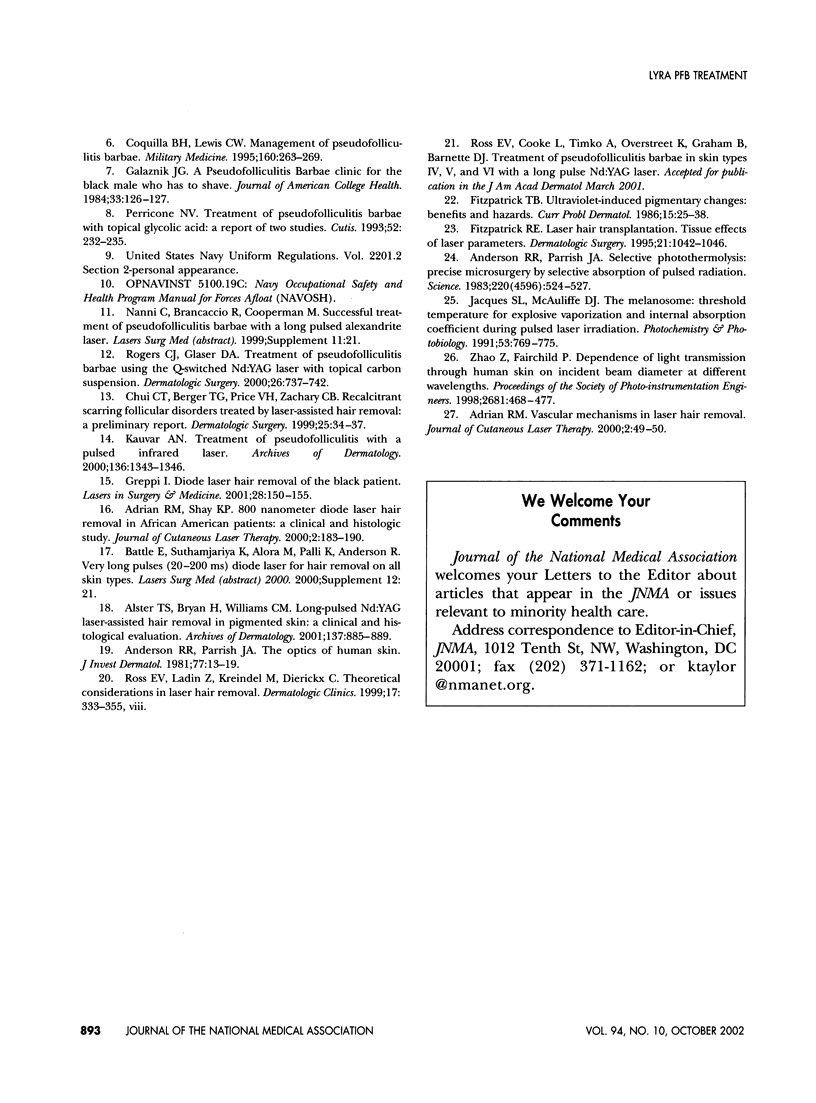
Images in this article
Selected References
These references are in PubMed. This may not be the complete list of references from this article.
- Adrian R. M., Shay K. P. 800 nanometer diode laser hair removal in African American patients: a clinical and histologic study. J Cutan Laser Ther. 2000 Dec;2(4):183–190. doi: 10.1080/146288300750163754. [DOI] [PubMed] [Google Scholar]
- Adrian R. M. Vascular mechanisms in laser hair removal. J Cutan Laser Ther. 2000 Mar;2(1):49–50. doi: 10.1080/14628830050516623. [DOI] [PubMed] [Google Scholar]
- Alexander A. M., Delph W. I. Pseudofolliculitis barbae in the military. A medical, administrative and social problem. J Natl Med Assoc. 1974 Nov;66(6):459-64, 479. [PMC free article] [PubMed] [Google Scholar]
- Anderson R. R., Parrish J. A. Selective photothermolysis: precise microsurgery by selective absorption of pulsed radiation. Science. 1983 Apr 29;220(4596):524–527. doi: 10.1126/science.6836297. [DOI] [PubMed] [Google Scholar]
- Anderson R. R., Parrish J. A. The optics of human skin. J Invest Dermatol. 1981 Jul;77(1):13–19. doi: 10.1111/1523-1747.ep12479191. [DOI] [PubMed] [Google Scholar]
- Braunder G. J., Flandermeyer K. L. Pseudofolliculitis barbae. 2. Treatment. Int J Dermatol. 1977 Jul-Aug;16(6):520–525. doi: 10.1111/j.1365-4362.1977.tb01868.x. [DOI] [PubMed] [Google Scholar]
- Brauner G. J., Flandermeyer K. L. Pseudofolliculitis barbae. Medical consequences of interracial friction in the US Army. Cutis. 1979 Jan;23(1):61–66. [PubMed] [Google Scholar]
- Brown L. A., Jr Pathogenesis and treatment of pseudofolliculitis barbae. Cutis. 1983 Oct;32(4):373–375. [PubMed] [Google Scholar]
- Chui C. T., Berger T. G., Price V. H., Zachary C. B. Recalcitrant scarring follicular disorders treated by laser-assisted hair removal: a preliminary report. Dermatol Surg. 1999 Jan;25(1):34–37. doi: 10.1046/j.1524-4725.1999.08100.x. [DOI] [PubMed] [Google Scholar]
- Conte M. S., Lawrence J. E. Pseudofolliculitis barbae. No 'pseudoproblem'. JAMA. 1979 Jan 5;241(1):53–54. [PubMed] [Google Scholar]
- Coquilla B. H., Lewis C. W. Management of pseudofolliculitis barbae. Mil Med. 1995 May;160(5):263–269. [PubMed] [Google Scholar]
- Fitzpatrick R. E. Laser hair transplantation. Tissue effects of laser parameters. Dermatol Surg. 1995 Dec;21(12):1042–1046. [PubMed] [Google Scholar]
- Fitzpatrick T. B. Ultraviolet-induced pigmentary changes: benefits and hazards. Curr Probl Dermatol. 1986;15:25–38. doi: 10.1159/000412090. [DOI] [PubMed] [Google Scholar]
- Galaznik J. G. A Pseudofolliculitis Barbae clinic for the black male who has to shave. J Am Coll Health. 1984 Dec;33(3):126–127. doi: 10.1080/07448481.1984.9936173. [DOI] [PubMed] [Google Scholar]
- Greppi I. Diode laser hair removal of the black patient. Lasers Surg Med. 2001;28(2):150–155. doi: 10.1002/lsm.1031. [DOI] [PubMed] [Google Scholar]
- Jacques S. L., McAuliffe D. J. The melanosome: threshold temperature for explosive vaporization and internal absorption coefficient during pulsed laser irradiation. Photochem Photobiol. 1991 Jun;53(6):769–775. doi: 10.1111/j.1751-1097.1991.tb09891.x. [DOI] [PubMed] [Google Scholar]
- Kauvar A. N. Treatment of pseudofolliculitis with a pulsed infrared laser. Arch Dermatol. 2000 Nov;136(11):1343–1346. doi: 10.1001/archderm.136.11.1343. [DOI] [PubMed] [Google Scholar]
- Perricone N. V. Treatment of pseudofolliculitis barbae with topical glycolic acid: a report of two studies. Cutis. 1993 Oct;52(4):232–235. [PubMed] [Google Scholar]
- Rogers C. J., Glaser D. A. Treatment of pseudofolliculitis barbae using the Q-switched Nd:YAG laser with topical carbon suspension. Dermatol Surg. 2000 Aug;26(8):737–742. doi: 10.1046/j.1524-4725.2000.00046.x. [DOI] [PubMed] [Google Scholar]
- Ross E. V., Ladin Z., Kreindel M., Dierickx C. Theoretical considerations in laser hair removal. Dermatol Clin. 1999 Apr;17(2):333-55, viii. doi: 10.1016/s0733-8635(05)70091-7. [DOI] [PubMed] [Google Scholar]



